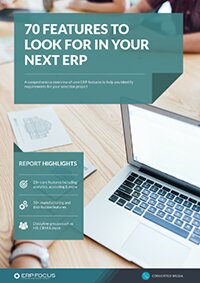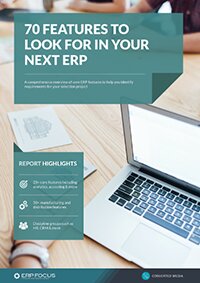How ERP software is addressing the challenges of new business models
By now, we’re pretty familiar with new business models brought about by the sharing economy. A tech conference can’t begin without the hackneyed “Uber, the world’s largest taxi company, owns no vehicles. Facebook, the world’s most popular media owner, creates no content. Alibaba, the most valuable retailer, has no inventory.”
Technology providers often find themselves in an arms race to provide the functionality and flexibility needed to support new and emerging workflows arising from app-based businesses. Traditional Enterprise Resource Planning (ERP) hasn’t always been able to keep up with these new trends, but thankfully there’s a solution: ERP as a platform, aka, Enterprise Resource Platform. Organizational platform first, with functionality on top.
GET ERP RESEARCH & KNOWLEDGE RIGHT TO YOUR INBOX
Covering the key issues faced by businesses selecting and implementing ERP.
While today’s ERP solutions were created with a specific function in mind, Enterprise Resource Platform Software is not bound to any preconceived idea. It exists to enable developers, and more importantly, non tech-savvy business users, to tailor it to meet their needs. So it’s the perfect tool to help your business navigate the constantly changing enterprise environment. Here are just a few building blocks that make up the Enterprise Resource Platform, and can help you address the challenges of new business models.
Flexibility
Today, competitive dynamics and the pace of change are so quick that most companies don’t know what their business model will be in the next 2-3 years. This means that business software solutions, including ERP, must be flexible and allow for business agility, to meet an organisations current and future needs. Because a business that’s not agile, or is constrained by their resource planning software, will fast become irrelevant.
Ideally, users and admins should be able to handle their own ERP systems, minimizing the dependency on third party vendors. This is best illustrated in ERP with a strong Business Process Management (BPM), the robust tools that define and change the business layer, making an organization’s workflow more efficient. These tools also include a graphical drag & drop User Interface (UI) to allow users to build or change workflows in minutes. Further, a modern ERP platform can offer a broader range of flexibility enablers, such as mobile application generators, so that users can build mobile apps with a few easy clicks, without the need for programming skills.
BYOD/mobility
With the rise of public Wi-Fi and the ‘bring your own device’ culture, mobility is becoming increasingly popular within businesses. It’s no longer a surprise to see people working from laptops, taking conference calls on the go, or emailing from their mobiles. In a recent survey of 500 senior business decision-makers, we found that while 95 per cent believed mobility increased productivity, over a third did not have the proper technology to fulfil its potential, and 43 per cent could not perform business-critical functions on a mobile application.
Decide what features you need in an ERP with this guide to 70 features to look for in your next ERP
While traditional ERP products were designed for desktops, modern ERP is designed for laptops, smartphones and tablets. As teams become more distributed, core business processes should become simple to do from remote locations as well. Applications for a mobile sales force, field technicians, proof of delivery and other sales and service-oriented roles must be part of your ERP solution. Mobile ERP apps enable field service reps to deliver smooth, seamless and efficient work in the field, with management also having full transparency and control.
Openness
Finally, one of the most important elements of a viable Enterprise Resource Platform is openness, as this allows for hyper-connected ERP with a new level of interoperability between the core business processes, external data, IoT devices, and third party applications.
System openness refers to the degree of accessibility to view, use and modify computer code in a shared environment. It creates new opportunities for more direct integration of the physical world into computer-based systems, resulting in improved efficiency, accuracy and revenues.
But to be truly open, an Enterprise Resource Platform must include standard APIs as well as dedicated SDKs. It's the convenient API layer that enables developers to integrate the ERP on both the database and application level with any third party or self-developed app.
A REST API in an ERP system, for example, enables rapid integration to external applications. With an API, any web developer can, for example, integrate your website and your CRM module. This means that your leads are automatically updated, and when integrated with your e-commerce website, any new orders via the site automatically create the order in the ERP. As part of the sales process, your e-commerce website will immediately show updated inventory and pricing information.
It's APIs that literally "open" the doors to real connectivity. For starters, openness through REST APIs enables seamless connection to an infinite number of sensors and connected devices allowing businesses to take full advantage of the IoT. For example, Automotive ERP software can be used for fleet management, where the ERP system tracks each vehicle in the fleet, generating reports on mileage, gas consumption, location and even current velocity.
Similarly, if your company is using ERP for manufacturing (i.e produces glass bottles), supported by APIs, sensors on the production floor measure the exact weight and volume of each drop of liquid glass into the mould. In real-time, the system delivers this data to the ERP backend, which immediately updates the inventory balance on the production floor to enable accurate material cost calculation.
So in conclusion, in its entirety, the Enterprise Resource Platform delivers the missing answers to questions that have been asked in the ERP eco-system for decades. For companies who want to keep up with the changes to their business models, being armed with business management software that will evolve as they evolve is crucial to success.
Free white paper

70 features to look for in your next ERP
A comprehensive guide to help you identify requirements for your ERP selection

Related articles
-

How to conduct a thorough ERP audit
The types of ERP audit, and step-by-step instructions on how to audit your ERP system
-

CMMC Compliance: What Aerospace and Defense Manufacturers Need to Know
Key insights on CMMC compliance, deadlines, and securing DoD contracts with CMMC 2.0 certificatio...
-
![Three direct links between ERP and manufacturing revenue [image by Snowing on Freepik] Three direct links between ERP and manufacturing revenue [image by Snowing on Freepik]](/pictures/W1siZiIsIjIwMjUvMDEvMjAva2ZwYjAzb3gzX1RocmVlX2RpcmVjdF9saW5rc19iZXR3ZWVuX0VSUF9hbmRfbWFudWZhY3R1cmluZ19yZXZlbnVlX2ltYWdlX2J5X1Nub3dpbmdfb25fRnJlZXBpa18uanBnIl0sWyJwIiwidGh1bWIiLCI0MDB4MjY2IyJdLFsicCIsImVuY29kZSIsImpwZyIsIi1xdWFsaXR5IDg1Il1d/Three%20direct%20links%20between%20ERP%20and%20manufacturing%20revenue%20%5Bimage%20by%20Snowing%20on%20Freepik%5D.jpg?sha=b45b02a140cc8680)
Three direct links between ERP and manufacturing revenue
What you need to know to help you achieve a return on your manufacturing ERP investment

